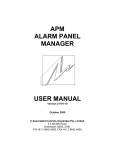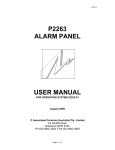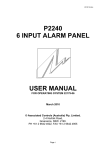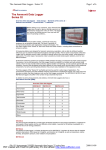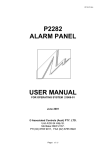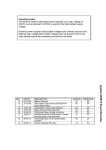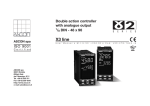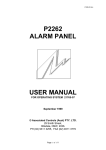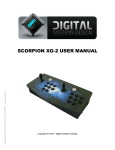Download User Manual - Ascon | Medical
Transcript
22197-02.doc P2267 NETWORK INTERFACE USER MANUAL FOR OPERATING SYSTEMS: 22031-03 23636-01 October 2009 © Associated Controls (Australia) Pty. Limited 2-4 Norfolk Road Greenacre, NSW, 2190. PH +61 2 9642 4922, FAX +61 2 9642 4955 Page 1 22197-02.doc Table of Contents 1. 2. 3. 4. Introduction P2267 Introduction Differences between firmware 22031-03 and 23636-01 3 3 Unit Description FRONT PANEL - Main Electronics Two 7 Segment Displays Eleven LED’s Two Pushbuttons RS232 Serial Port Socket Relay Outputs Network Termination Links Power Connector Serial Communications Connectors Network Socket Mode Links 5 5 5 6 6 6 6 6 6 7 8 Unit Operation Use of Unit Monitor Mode Test Mode Terminal Mode System Messages 9 9 10 10 12 Specifications Specifications 13 Page 2 22197-02.doc 1 Introduction P2267 INTRODUCTION The P2267 Network Interface is designed to all the alarm panels on a network and converts the alarm information into a protocol compatible with a BMS. The currently supported BMS protocol is ModBus RTU. Network connection is made directly to the main electronics via an 8 way plug. Serial Data connection (commonly connected to a BMS) is made directly to the main electronics via a set of terminal blocks for either RS232 or RS485/422. 8 programmable relay outputs are available and connection is made via a set of terminal blocks. All P2267 programming is done via a 4 pin RS232 plug and socket that couples it to a computer. This feature permits full custom set up of Relay Outputs and Active Units. DIFFERENCES BETWEEN FIRMWARE 22031-03 AND 23636-01 The 23636-01 special version firmware is based on the 22031-03 standard version firmware that is used for all installations. “u1” is displayed on the P2267 at power up. The P2267 presents to the BMS system either 9 (P228x) or 25 (P226x) Holding Registers that show the current status of the Alarm Panel TIMER (Register 1) and any connected ALARM INPUTS (Register 2 – 9/25). See Section 3 below for all the operational details. In normal operation, the TIMER will have a value of usually 80 – 90 with the value counting down from 90 until it is reset by the alarm panel back to 90. The ALARM INPUTS will have a value of 0 for non alarm and 255 for alarm. This version of firmware removes the Alarm Panel Global Reset feature from the P2267. Normally when an alarm panel goes offline any connected alarm panel with Remote Alarms for the offline panel will send the panel a reset command. This is standard operation for the panels. A typical network using a P2267 will have the alarm panels having only local alarms with any alarm being repeated through the P2267 to the BMS system. In this case, the only time a reset command would be sent was if an alarm panel was having some rather big Page 3 22197-02.doc communications problems. The P2267 would receive this command and reset itself in order to allow the network to stabilise. Upon resetting the P2267 losses all TIMER register information and the count returns to 90. It has been determined that some installations using a P2267 have alarm panels with both local and remote alarms. This would cause reset messages to be broadcast if an alarm panel went offline. The P2267 interprets any reset message as a global message because the P2267 itself is transparent and is unknown to the alarm panels so it would reset itself to ensure the network is completely stabilised. This is an undesired feature in this kind of network. The 23636-01 revision firmware disables the Alarm Panel Global Reset feature which allows the TIMER registers to time out down to 0 when an alarm panel goes offline and this allows the BMS to correctly interrogate the register. Associated Controls has tested this network in our factory and can see no reason why the network would fail due to the P2267 with this version of firmware. It is the responsibility of the installer and network maintenance to understand how the 23636-01 version firmware works so that any faults can be quickly corrected. Page 4 22197-02.doc 2 Unit Description FRONT PANEL - Main Electronics The main electronics PCB is mounted in a metal enclosure that can be mounted to any surface. The front panel presents the operator with the following items: • Two 7 segment displays. • Eleven LED’s. • Two pushbuttons – Network and Test. Two 7 Segment Displays: This is used to convey basic information to the operator. 1) Firmware Revision – at power up, the P2267 will display the current firmware revision for 2 seconds. “03” or “u1” depending on the firmware version. 2) Terminal Mode – when connected to a computer for setup purposes, the P2267 will display “co” initially until commands are received from the computer. 3) File Transmission – when downloading data to the P2267, the display will show one of six values indicating the current status of the transfer. (See “Terminal Mode”) 4) Serial Data Processing – when the P2267 is operating in Monitor Mode, the two decimal points of the displays act as data processing indicators. The MSD point indicates successful incoming data processing, and the LSD point indicates successful outgoing data processing. Eleven LED’s: There are 11 LED’s associated with the panel. 1) Power LED – Indicates power to the unit is within limits. 2) Network Data LED – Indicates data on the network. 3) Service LED – Indicates the network configuration (See the APM Manual for more information about setting up the network). 4) Relay Active LED’s – Indicates the activation of one of the eight relay outputs. Page 5 22197-02.doc Two Pushbuttons: There are two pushbuttons – Test and Network. 1) Test – Initiates the Test mode from which three options are available. 2) Bind – Used to commission the panel into the network. RS232 SERIAL PORT SOCKET The RS232 connection is made via a 4 way RJ45 (See Figure 5). When connected to a computer running “APM” software supplied by Associated Controls, the operator can configure the P2267 as required. RELAY OUTPUTS There are 8 relays that can be programmed to operating when a specific panel and alarm number combination occur. Programming of the relays is done specifically in APM. The connectors to the relays are on the right hand side of the unit. Each relay has a Common and a Normally Open and Normally Closed set of contacts. The relays are energised during the normal operation of the unit and will close the contacts when power is lost. NETWORK TERMINATION LINKS While the network system used by the P2267 is of a “Free Topology” nature, it still requires one termination on the network. It is not critical where the termination should be, so long as it is there. Each panel has the ability to provide the termination, only one on the network is required. There is a link block beside the 8 way RJ45 connectors marked as “NETWORK TERMINATION”. To provide termination the link should be installed, if termination is not required the link should be left out. POWER CONNECTOR Power connection is made using the two way terminal block on the upper right hand side of the unit. SERIAL COMMUNICATIONS CONNECTORS The P2267 offers three types of media for connection to a BMS. The RS232 mode is not used but is made available for later expansion. The Page 6 22197-02.doc other two types are RS485 and RS422 with both Full and Half duplex modes available. The connectors are located on the left hand side of the unit. NETWORK SOCKET The network connection is made via either one of two 8 way sockets left hand side. Two sockets are provided, should a “daisy chain” wiring configuration be required. The system wiring can be of any configuration as shown if Fig 1 to 4 below, however there are limits on the cable length. The maximum total wire length in the installation is 450 metres and the maximum distance between any nodes to any node, or a termination is 250 metres. The cable length figures above apply to a category 5 UTP solid twisted pair cable. Only 2 of the 8 ways of the network socket are used at this stage, (see specifications for pin-outs) 8way is provided for future expansion. There is also an 8 way terminal block that presents the network in case of a twisted pair application but this system is not supported by Associated Controls as intermittent faults can occur due to cable tolerances. Figure 1 Loop Topology Figure 2 Mixed Topology Page 7 22197-02.doc Figure 3 Single Terminated Bus Topology Figure 4 Star Topology MODE LINKS The P2267 has 5 links that are used for configuring the serial communications modes. J9 and J10 These two jumpers are used to terminate the serial communications as required. J10 is selected for half-duplex communications and both J9 and J10 should be selected for fullduplex communications if required. Terminal of a RS485/422 network should follow the required standards to attain the greatest compatibility and to minimise noise problems caused by incorrect terminations and cable impedances. J11 J11 determines the duplex nature of the communications. When the jumper is across pins 2 & 3 (the 2 most right pins of the pinblock) the P2267 will operate in half-duplex mode. When the jumper is across pins 1 & 2 (the 2 most left pins of the pinblock) the P2267 will operate in full-duplex mode. J12 and J13 These two jumpers select the phasing of the twisted pair lines. The P2267 is set up at the factory for normal phasing (the 2 most left pins are selected), but if it occurs that the lines are reversed, the two jumpers can be swapped to reversed phasing (the 2 most right pins are selected). Page 8 22197-02.doc 3 Unit Operation USE OF UNIT From the user point of view there is very little to know. The unit can be mounted away from every day access as it only transfers data from one system to another and does not actively contribute to alarm status or provide useable output from a layman point of view. The P2267 has four main modes of operation. MONITOR MODE The monitor mode is the normal operation of the interface. In this mode, the panel provides continuous monitoring of the network and serial communication. The interface acts as a transparent connector between the ASCON Alarm Panel Network and the ModBus Network. Each Alarm Panel has its own Unit ID number (generated in the APM program). The interface allows the Master ModBus device to access each of the Alarm Panels as if they existed on the ModBus Network. Each Alarm Panel is accessed by its Unit ID which becomes its Slave Number. An Alarm Panel has 25 holding registers which can be interrogated by the Master. The ModBus Registers that are accessible are the 40000 series 16bit Data Holding Registers. The following is a list of the available registers: 24 Input Panel Reg # 1 2 3 4 5 6 7 8 9 10 11 12 13 14 15 16 Value Timer Alarm 1 Alarm 2 Alarm 3 Alarm 4 Alarm 5 Alarm 6 Alarm 7 Alarm 8 Alarm 9 Alarm 10 Alarm 11 Alarm 12 Alarm 13 Alarm 14 Alarm 15 8 Input Panel Reg # 1 2 3 4 5 6 7 8 9 10 11 12 13 14 15 16 Page 9 Value Timer Alarm 1 Alarm 2 Alarm 3 Alarm 4 Alarm 5 Alarm 6 Alarm 7 Alarm 8 N/A N/A N/A N/A N/A N/A N/A 22197-02.doc 17 18 19 20 21 22 23 24 25 Alarm 16 Alarm 17 Alarm 18 Alarm 19 Alarm 20 Alarm 21 Alarm 22 Alarm 23 Alarm 24 17 18 19 20 21 22 23 24 25 N/A N/A N/A N/A N/A N/A N/A N/A N/A Register #1 is the heartbeat timer for the Alarm Panel. If the Panel is currently active on the network it heartbeats the network to make sure that the network is operational. If the interface does not receive a heartbeat from an allocated panel, the timer will eventually reach zero. This register can be monitored to make sure that an Alarm Panel is working correctly. If the register contains a value of $0000 (hexadecimal 0000, decimal 0, 16bit) then the Alarm Panel has not accessed the network and a problem may be occurring with the Panel. Registers #2 - #25 are the actual inputs of the Alarm Panel. The P2262/P2500 uses all 24 registers, while the P2281/P2282 only uses 8. When an input is normal, the register will contain a value of $0000 (hexadecimal 0000, decimal 0, 16bit). When the input is in alarm, the register will contain a value of $00FF (hexadecimal 00FF, decimal 255, 16bit). If there are to be several Interface units connecting two or more ASCON Networks to a ModBus Master, each Panel must have a unique Unit ID. The system will only support up to 120 Unit ID’s, remembering that each interface unit will have its own Unit ID. For example: if there are two networks to be connected to a ModBus Master and each network has 10 panels, there need to be 2 interface units which leaves 120 – ((2 x 10) + 2) = 98 Unit ID’s left. TEST MODE The test mode is selected by the Test pushbutton. Activating this mode puts the unit into a test routine that cycles numbers on the two 7 segment displays and then activates each relay one by one. The unit then returns to Monitor Mode. TERMINAL MODE With the exception of those hardware features already described, the P2267 is configured at installation using “APM” (Alarm Panel Management) software supplied by Associated Controls. The “APM” software is run on a suitable computer connected to the P2267 interface via the RS232 socket. Page 10 22197-02.doc The “APM” software has its own User Manual giving detailed instruction on its use. A summary only of the features will be given here. The “APM” software has two sections. 1) File Generation Mode File generation is the first step in setting up a P2267 panel. It contains all the allocated relay outputs and all the active units within the network. It also contains a unique panel ID number and identification message. The computer need not be connected to the P2267 at this stage. This file can be downloaded to a P2267 interface using the second section “monitor/terminal mode”. No further interface setup is required if the file information is correct. The downloading of files into the P2267 should only be done after all panels have been entered into the project as the active units are allocated automatically by APM during file generation. 2) Terminal Mode The Terminal Mode is used to communicate with the P2267, the computer must be connected to the P2267 when using this section. When the communications cable is connected to the P2267 panel the display will show “co” when the unit is ready to proceed. The functions provided in monitor mode are as follows: Download – used to send a file generated under “File Generation” to the P2267. Display Setup – will display the current panel setup information: Software Revision Unit / Slave ID Unit Message ID Number Of Relay Outputs Number Of Active Units Current Baud Rate Current Media Type Current Protocol Mode Current ModBus Type Page 11 22197-02.doc SYSTEM MESSAGES The P2267 has several system messages that can occur when transferring data from the computer. “90” “91” “92” “93” “94” “95” Loading File in progress. File received OK. EEPROM ERROR – return unit for servicing. BYTECOUNT ERROR – transfer error, please retry. CHECKSUM ERROR – transfer error, please retry. Data saved OK – Please reset unit manually. Page 12 22197-02.doc 4 Specifications SPECIFICATIONS Power Consumption Operating Voltage Current Consumption Power Consumption 12 Volts AC or DC +/- 10% 0.3 Amps 3.6 Watts Environmental Conditions Operating Temperature Range Operating Humidity Range 0 - 45 Deg C 95% R.H. non-condensing Relay Output Alarm status relay contact rating 1A @ 30V DC RS232 PC Communications Serial Output Format 1200 Baud, 8 Bit, 1 Stop, No Parity RS422/485 Compatible with EIA-422 and EIA-485 standards. Recommended cable as per standards. ModBus Format RTU Mode, 9600 Baud, 1 Start, 8 Data, No Parity, 1 Stop Network Information Cable Type Category 5 UTP solid Cable Length Maximum total length in system Maximum length node to any node or termination 450 metres 250 metres Network Frequency 78 kbps Maximum Number of Nodes 30 Page 13 22197-02.doc Socket Connections Pin numbering runs left to right Figure 5 Figure 6 numbering applies to both 4 way RS232 socket and 8 way Network sockets RS232 4 Way Pin No. 1 2 3 4 Function Common ( Ground ) N/C TXD ( Data Out ) RXD ( Data In ) Network 8 Way Pin No. 1 2 3 4 5 6 7 8 Function N/C N/C N/C N/C N/C N/C Network Network RS422/485 6 Way Pin No. 1 2 3 4 5 6 Function Full Duplex (+) Full Duplex (-) Shield Half Duplex (+) Half Duplex (-) Shield Page 14















